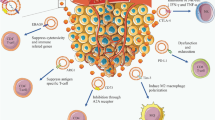Abstract
Exosomes are small membrane vesicles originating from late endosomes and secreted by hematopoietic and epithelial cells in culture. Exosome proteic and lipid composition is unique and might shed some light into exosome biogenesis and function. Exosomes secreted from professional antigen-presenting cells (i.e., B lymphocytes and dendritic cells) are enriched in MHC class I and II complexes, costimulatory molecules, and hsp70–90 chaperones, and have therefore been more extensively studied for their immunomodulatory capacities in vitro and in vivo. This review will present the main biological features pertaining to tumor or DC-derived exosomes, will emphasize their immunostimulatory function, and will discuss their implementation in cancer immunotherapy.

Similar content being viewed by others
Abbreviations
- APC:
-
antigen-presenting cell
- ASI:
-
active specific immunotherapy
- CTL:
-
cytotoxic T lymphocyte
- DC:
-
dendritic cell
- FDC:
-
follicular dendritic cell
- MD-DC:
-
monocyte-derived dendritic cell
- GMP:
-
good manufacturing procedure
- HLA:
-
human leukocyte antigen
- HSP:
-
heat shock protein
- MHC:
-
major histocompatibility complex
- MVB:
-
multivesicular body
- ExAs:
-
ascitis-derived exosomes
- DEX:
-
DC-derived exosome
- TEX:
-
tumor cell–derived exosome
References
Denzer K, Kleijmeer MJ, Heijnen HF, Stoorvogel W, Geuze HJ (2000) Exosome: from internal vesicle of the multivesicular body to intercellular signaling device. J Cell Sci 113:3365–3374
Denzer K, van Eijk M, Kleijmeer MJ, Jakobson E, de Groot C, Geuze HJ (2000) Follicular dendritic cells carry MHC class II-expressing microvesicles at their surface. J Immunol 165:1259–1265
Quah B, O’Neill HC (2000) The application of dendritic cell-derived exosomes in tumour immunotherpy. Cancer Biother Radiopharm 15:185–194
André F, Schartz NE, Movassagh M, Flament C, Pautier P, Morice P, Pomel C, Lhomme C, Escudier B, Le Chevalier T, Tursz T, Amigorena S, Raposo G, Angevin E, Zitvogel L (2002) Malignant effusions and immunogenic tumor derived-exosomes. Lancet 360:295–305
Zitvogel L, Regnault A, Lozier A, Wolfers J, Flament C, Tenza D, Ricciardi-Castagnoli P, Raposo G, Amigorena S (1998) Eradication of established murine tumors using a novel cell-free vaccine: dendritic cell-derived exosomes. Nat Med 4:594–600
Wolfers J, Lozier A, Raposo G, Regnault A, Thery C, Masurier C, Flament C, Pouzieux S, Faure F, Tursz T, Angevin E, Amigorena S, Zitvogel L (2001) Tumor-derived exosomes are a source of shared tumor rejection antigens for CTL cross-priming. Nat Med 7:297–303
Johnstone RM, Adam M, Hammond JR, Orr L, Turbide C (1987) Vesicle formation during reticulocyte maturation: association of plasma membrane activities with released vesicles (exosomes). J Biol Chem 262:9412–9420
Raposo G, Tenza D, Mecheri S, Peronet R, Bonnerot C, Desaymard C (1997) Accumulation of major histocompatibility complex class II molecules in mast cell secretory granules and their release upon degranulation. Mol Biol Cell 8:2631–2645
Escola JM, Kleijmeer MJ, Stoorvogel W, Griffith JM, Yoshie O, Geuze HJ (1998) Selective enrichment of tetraspan proteins on the internal vesicles of multivesicular endosomes and on exosomes secreted by human B-lymphocytes. J Biol Chem 273:20121–20127
Arnold PY, Mannie MD (1999) Vesicles bearing MHC class II molecules mediate transfer of antigen-presenting cells to CD4+ cells. Eur J Immunol 29:1363–1373
Heijnen IA, van Vugt MJ, Fanger NA, Graziano RF, de Wit TP, Hofhuis FM, Guyre PM, Capel PJ, Verbeek JS, van de Winkel JG (1996) Antigen targeting to myeloid-specific human Fc gamma RI/CD64 triggers enhanced antibody responses in transgenic mice. J Clin Investig 97:331–338
Hess C, Sadallah S, Hefti A, Landmann R, Schifferli JA (1999) Ectosomes released by human neutrophils are specialized functional units. J Immunol 163:4564–4573
Patel DM, Arnold PY, White GA, Nardella JP, Mannie MD (1999) Class II MHC/peptide complexes are released from APC and are acquired by T cell responders during specific antigen recognition. J Immunol 163:5201–5210
Geminard C, Nault F, Johnstone RM, Vidal M (2001) Characteristics of the Interaction between Hsc70 and the transferrin receptor in exosomes released during reticulocyte maturation. J Biol Chem 276:9910–9916
Skokos D, Le Panse S, Villa I, Rousselle JC, Peronet R, David B, Namane A, Mecheri S (2001) Mast cell-dependent B and T lymphocyte activation is mediated by the secretion of immunologically active exosomes. J Immunol 166:868–876
Thery C, Zitvogel L, Amigorena S (2002) Exosomes: composition, biogenesis and function. Nat Rev Immunol 2:569–579
Yang S, Kittlesen D, Slingluff CL Jr, Vervaert CE, Seigler HF, Darrow TL (2000) Dendritic cells infected with a vaccinia vector carrying the human gp100 gene simultaneously present multiple specificities and elicit high-affinity T cells reactive to multiple epitopes and restricted by HLA-A2 and -A3. J Immunol 164(8):4204–4211
Dhodapkar MV, Steinman RM, Krasovsky J, Munz C, Bhardwaj N (2001) Antigen-specific inhibition of effector T cell function in humans after injection of immature dendritic cells. J Exp Med 193:233–238
Chaput N, André F, Schartz NEC, Escudier B, Turz T, Angevin E, Zitvogel L (2003) Proc Am Assoc Cancer Res 44:A4746
Théry C, Duban L, Segura E, Véron P, Lantz O, Amigorena S (2002) Exosomes activate naive CD4+ T cells by transfer of MHC/peptide complexes to dendritic cells. Nat Immunol 3:1156–1162
Lamparski H, Metha-Damani A, Yao J, Patel S, Hsu D, Ruegg C, Le Pecq J (2002) Production and characterization of clinical grade exosomes derived from dendritic cells. J Immunol Meth 270(2):211
H. Pêche (2001) Club Francophone Des Cellules Dendritiques, p 31 (Abstract C08)
E. Angevin (2002) 7th International Symposium on Dendritic Cells, p 28 (Abstract 20)
Author information
Authors and Affiliations
Corresponding author
Additional information
This work was presented at the first Cancer Immunology and Immunotherapy Summer School, 8–13 September 2003, Ionian Village, Bartholomeio, Peloponnese, Greece.
Rights and permissions
About this article
Cite this article
Chaput, N., Taïeb, J., Schartz, N.E.C. et al. Exosome-based immunotherapy. Cancer Immunol Immunother 53, 234–239 (2004). https://doi.org/10.1007/s00262-003-0472-x
Received:
Accepted:
Published:
Issue Date:
DOI: https://doi.org/10.1007/s00262-003-0472-x




